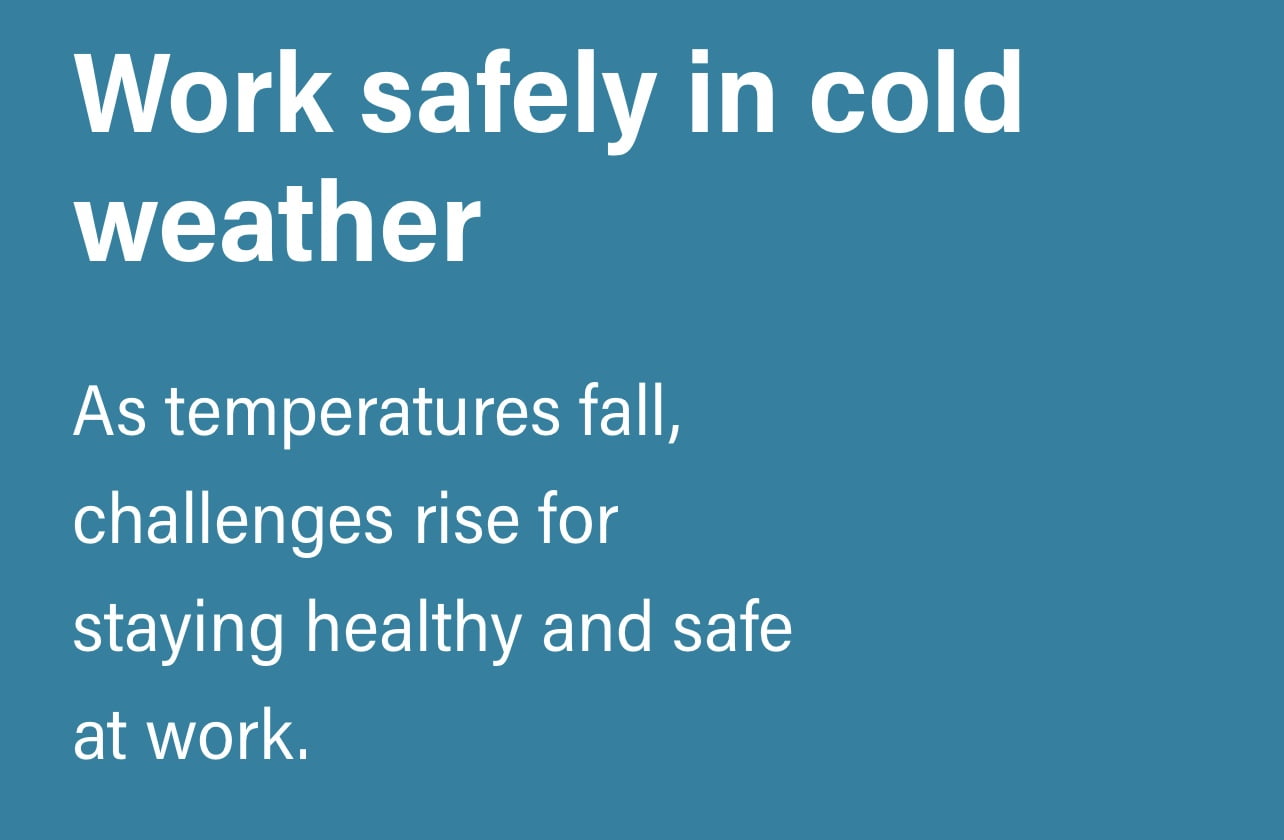
Work Safely in Cold Temperatures
With extreme cold temperatures this Christmas, please understand that extreme cold is a workplace hazard.
That means employers need to take steps to reduce risks to workers associated with cold weather such as severe cold stress and hypothermia.
What employers can do:
- add a heater or heated shelter to the work site
- implement a work/warm-up schedule
- shield workers from drafts or wind as much as possible
- allow workers extra breaks if needed
- educate workers on the hazards of working in the cold and put controls in place to protect them
- implement a buddy system so no one works alone
How to stay warm:
- use layered or insulated clothing
- cover exposed skin
- take breaks inside
- keep footwear dry
- keep moving to generate body heat but avoid sweating
Early warning signs of cold stress:
- feeling cold and shivering
- having trouble moving fingers, hands and toes, loss of feeling or tingling
- frost nip, when the top layers of skin turn white
- irritability, confusion or loss of coordination
Vulnerability to cold-related injury varies from person to person. Factors such as age, medical conditions, general health and fitness level can make people more or less susceptible to feeling extreme cold.

Whilst you are here, have a read of this
Steps to Cold Weather Safety
- Check the Environment Canada weather forecast before going out.
- Listen for a wind chill warning. Warnings are based on local climate and are issued when significant wind chills are expected.
- Visit Environment Canada’s new Weather and Meteorology website: http://ec.gc.ca/meteo-weather/
Weather forecasts are available through radio and TV broadcasts, Environment Canada’s Weatheradio service, and online at www.weatheroffice.gc.ca.
Plan ahead
- Develop a cold weather safety plan in advance to ensure that safety concerns are addressed when it’s very cold, or when the wind chill is significant. For example, schools could hold recess indoors, outside workers could schedule warm-up breaks, and those involved in winter recreation could reduce the amount of time they spend outdoors.
Dress warmly
- Dress in layers, with a wind resistant outer layer.
- When it is cold, wear a hat, mittens or insulated gloves. Keep your face warm with a scarf, neck tube or facemask.
- Wear warm and waterproof footwear. When it is very cold, or when the wind chill is significant, cover as much exposed skin as possible. Your body’s extremities, such as the ears, nose, fingers and toes lose heat the fastest.
Seek shelter
- When the wind chill is significant, get out of the wind and limit the time you spend outside.
Stay dry
- Wet clothing chills the body rapidly.
- Remove outer layers of clothing or open your coat if you are sweating.
Keep active
- Walking or running will help warm you by generating body heat.
Be aware
- Watch for signs of frostbite and hypothermia (see below).
- Some people are more susceptible to the cold, particularly children, the elderly and those with circulation problems.
- Check on elderly relatives and neighbours to ensure they are warm enough and have sufficient supplies, particularly when the weather is cold or snowy. They might not feel comfortable going outside to shop and may require food, medications and other supplies.
- The use of alcohol, tobacco and certain medications will increase your susceptibility to cold.
Hypothermia
- Being cold over a prolonged period of time can cause a drop in body temperature
- Shivering, confusion and loss of muscular control (e.g., difficulty walking) can occur.
- It can progress to a life-threatening condition where shivering stops or the person loses consciousness. Cardiac arrest may occur.
What to do:
- Get medical attention immediately.
- Lay the person down and avoid rough handling, particularly if the person is unconscious.
- Get the person indoors.
- Gently remove wet clothing.
- Warm the person gradually and slowly, using available sources of heat.
Frostbite
- A more severe condition, where both the skin and the underlying tissue (fat, muscle, bone) are frozen.
- Skin appears white and waxy and is hard to the touch.
- No sensation – the area is numb or tingling.
What to do:
- Frostbite can be serious, and can result in amputation. Get medical help!
- Do not rub or massage the area.
- Do not warm the area until you can ensure it will stay warm.
- Warm the area gradually; use body heat, or warm water (40°C to 42°C). Avoid direct heat which can burn the skin.



